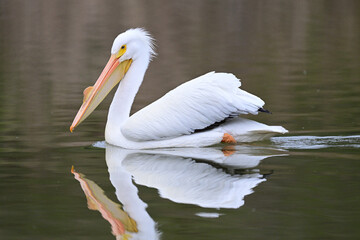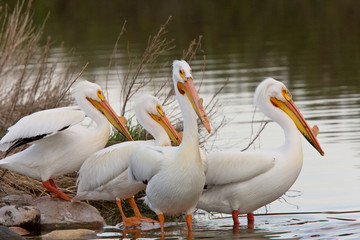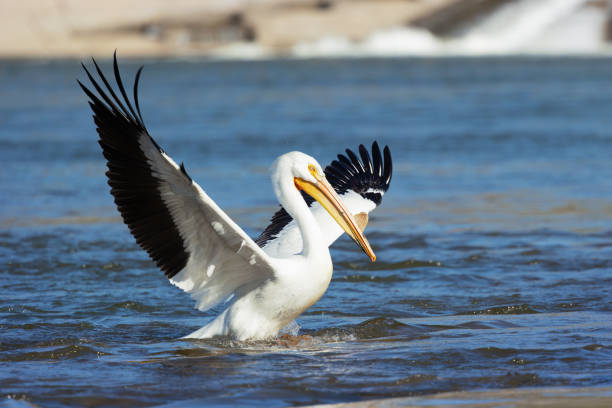Table of Contents
Scientific Classification
- Kingdom: Animalia
- Phylum: Chordata
- Class: Aves
- Order: Pelecaniformes
- Family: Pelecanidae
- Genus: Pelecanus
- Species: Pelecanus erythrorhynchos
- Scientific Name: Pelecanus erythrorhynchos
Description
The American White Pelican (Pelecanus erythrorhynchos) is one of North America’s largest birds. It has dazzling white feathers, a long orange bill, and a large wingspan. These features make it easy to recognize. This bird is a true marvel of nature. It is 50 to 70 inches (127 to 178 cm) long. Its wingspan can reach 9 feet (2.7 meters). Despite their size, these pelicans are graceful in flight. They are often seen soaring high in the sky with slow, deliberate wingbeats. Their black flight feathers, seen only in flight, are striking. They contrast beautifully with their white body.
The American White Pelican has a huge bill. It can be 15 inches (38 cm) long. The bill has an expandable pouch. It lets the bird scoop up fish and water. Then, it drains the excess liquid before swallowing its prey. This adaptation is vital for survival. They rely on efficient fishing to meet their energy needs. During the breeding season, males grow a fibrous plate on their bill. It’s thought to aid courtship displays.
The American White Pelican takes a different route than the Brown Pelican. The Brown Pelican dives dramatically to catch fish. The American White Pelican uses a more strategic method. These birds use teamwork to herd fish into shallow waters, where they can be easily scooped up. It is fascinating to observe pelicans’ cooperative hunting. Their flocks work together, moving in sync to corner their prey.
American White Pelicans are very social. They form large colonies for breeding and migration. They are common in freshwater lakes, wetlands, and coastal areas with plenty of food. They are mostly silent birds. They use low grunts and hisses to communicate. This is especially true when interacting with mates or rivals.
Another remarkable aspect of these pelicans is their seasonal migration. In summer, they breed in the northern U.S. and Canada. They nest on isolated islands where their eggs and chicks are safe from predators. As temperatures drop, they migrate to warmer areas, like the Gulf of Mexico and Central America, where food is plentiful.
The American White Pelican is a captivating North American bird. Its elegance, unique feeding, and social nature make it so. Their ability to adapt, and their strong sense of community, have let them thrive in many habitats. But, like many wildlife species, they face threats. Their habitat is lost, polluted, and harmed by humans. We must conserve these magnificent birds. They should grace the skies for generations to come.

Distribution
You can find the American White Pelican across North America. It breeds in inland freshwater lakes and wetlands. It breeds from Canada and the northern U.S. to the Great Plains. In winter, these birds migrate to warmer coastal areas. They go to the Gulf of Mexico, Southern California, and Central America.
Habitat
American White Pelicans prefer shallow lakes, rivers, and marshes where fish are abundant. They nest on isolated islands in freshwater lakes, away from predators. In winter, they prefer coastal estuaries, lagoons, and sheltered bays. There, they can find plenty of food.
Diet
These pelicans are piscivorous, which means their diet consists of fish. However, they also consume crustaceans, amphibians, and other aquatic organisms. Unlike Brown Pelicans, which dive for fish, American White Pelicans work in groups. They herd fish into shallow waters to ease their capture. Their diet consists primarily of small fish, such as minnows, carp, and catfish. They scoop them up in their expandable throat pouch.
Behavior
American White Pelicans are social birds. They often flock during migration and winter. They are known for their synchronized flight formations. They conserve energy during long migrations. When feeding, they often cooperate. They swim in unison to corral fish into tight areas. Unlike many birds, these pelicans are mostly silent. They only make low grunts or hisses during mating or interactions.

Lifespan
In the wild, American White Pelicans typically live between 15 and 25 years. In captivity, they are safe from predators and have a steady food supply. So, they can live even longer. Their longevity depends on habitat quality, food, and human threats.
Reproduction and Lifecycle
Breeding season for the American White Pelican begins in late spring, in April and May. They form monogamous pairs for the season. Both parents share duties. They incubate the eggs and feed the young. Nesting colonies are usually on remote islands. They build simple nests of sticks and plants. The female usually lays two eggs. However, often only one chick survives because of sibling competition. Chicks hatch after about a month. They rely on their parents for food for several weeks before fledging.

Predators
Adult American White Pelicans have few natural predators due to their size. Eggs and chicks face threats from foxes, coyotes, raccoons, and big birds of prey. This includes eagles and gulls. Also, human activities, like habitat destruction and pollution, threaten their survival.
Adaptations
American White Pelicans have evolved adaptations. They make them efficient in their environment.
- Large Bill and Pouch: Their iconic bill lets them scoop fish. The pouch stores water and prey.
- Cooperative Hunting: They work together to herd fish into shallow water, not to dive. This increases their feeding success.
- Strong Wings: With a wingspan of up to 9 feet, they are excellent gliders. They use thermals to soar high above the ground over long distances during migration.
- Webbed Feet: Their webbed feet make them strong swimmers. They can move with speed through the water while hunting for food.
Conservation Status
The IUCN lists the American White Pelican as least concern. However, still faces threats.
These include:
- Wetland drainage
- Pollution from pesticides and heavy metals.
- Human activity near nesting sites
Efforts like habitat protection, pollution control, and wetland restoration are vital. They help keep wildlife populations stable.
Conclusion
The American White Pelican is an extraordinary bird. It captivates birdwatchers and nature lovers alike. Its size, cooperation, and unique traits make it a remarkable species. It thrives in North America’s lakes, rivers, and coasts. Though not endangered, we must protect their habitats. This will let future generations admire these magnificent birds in the wild.



